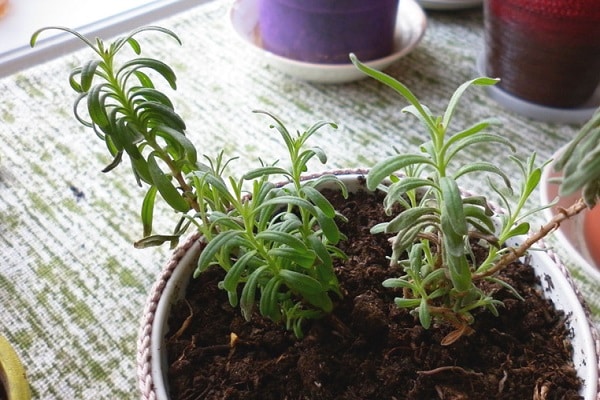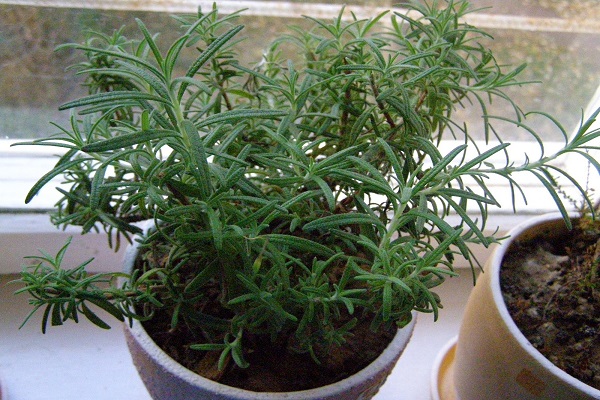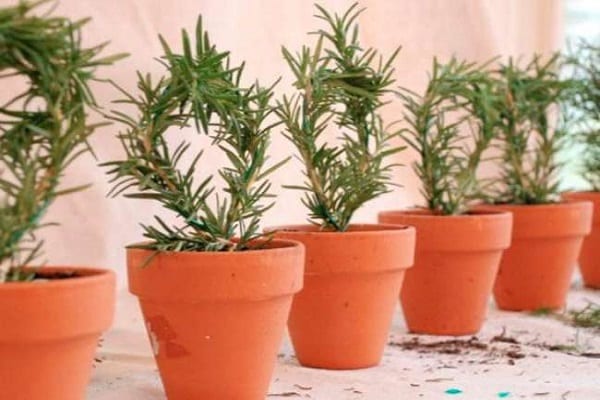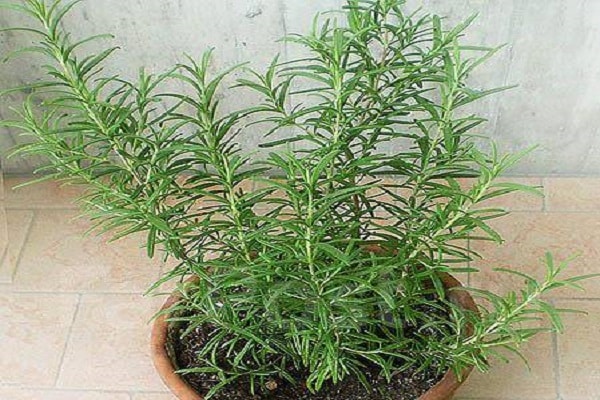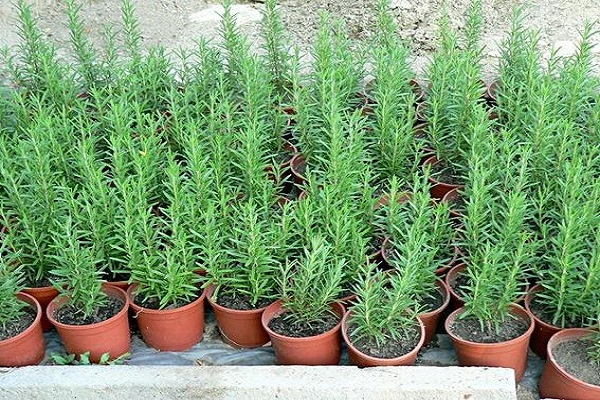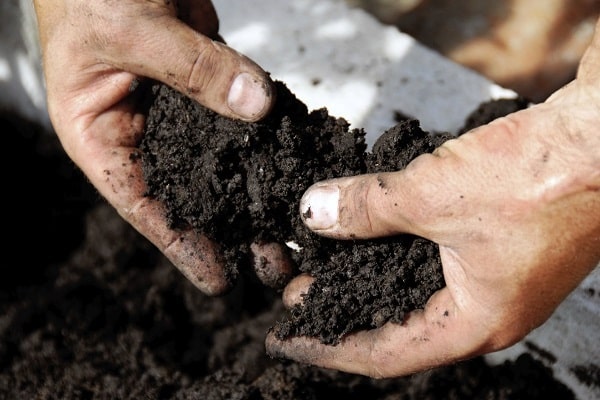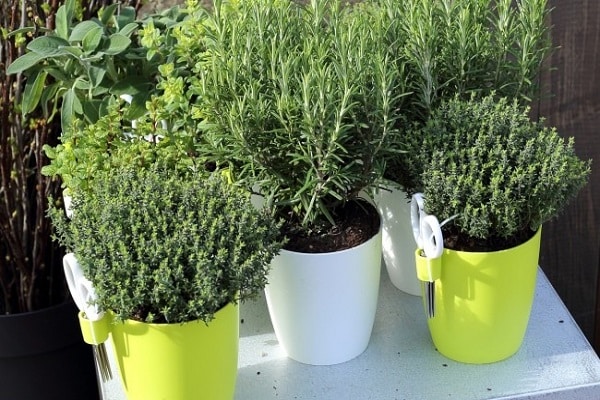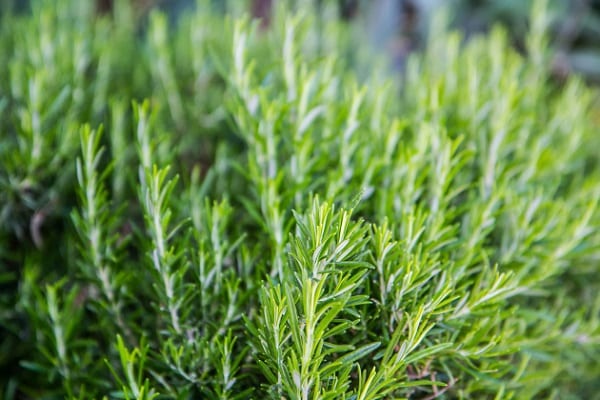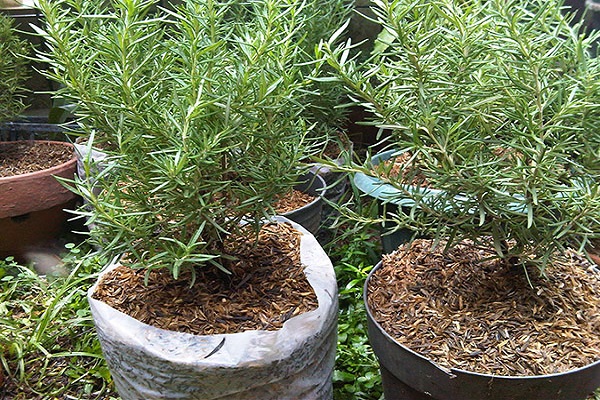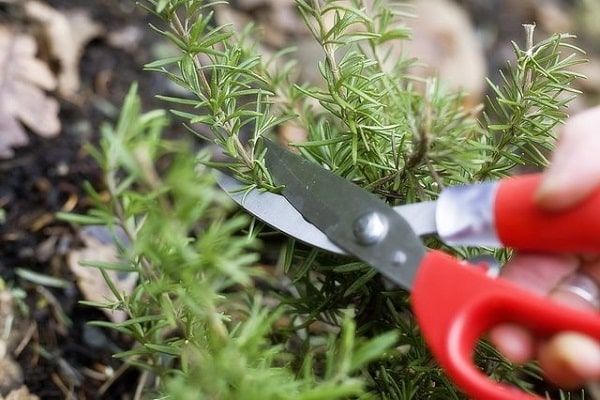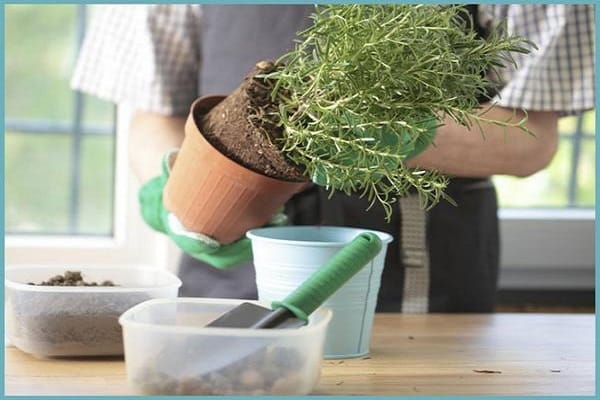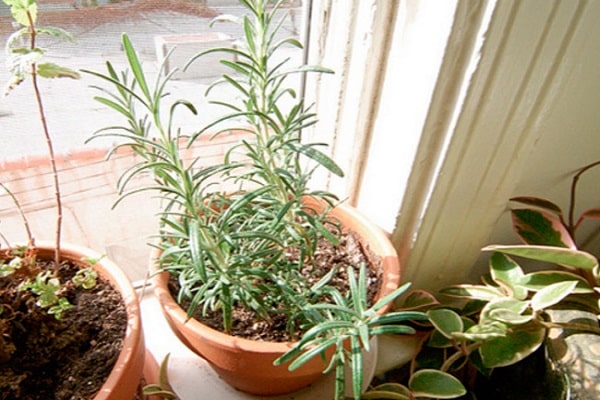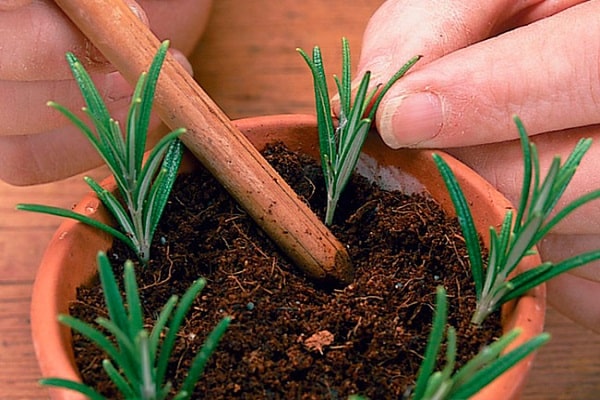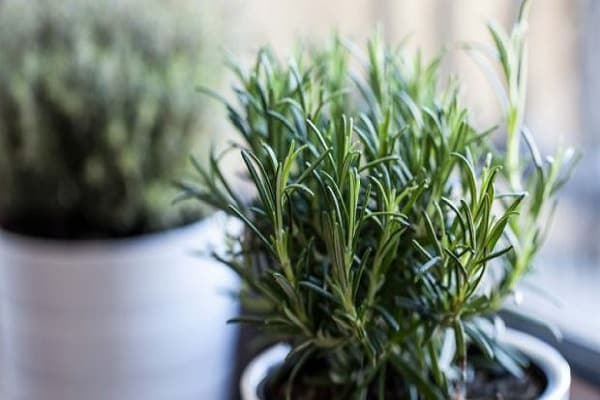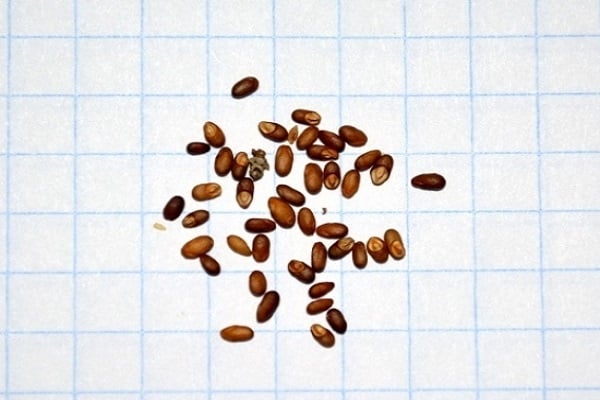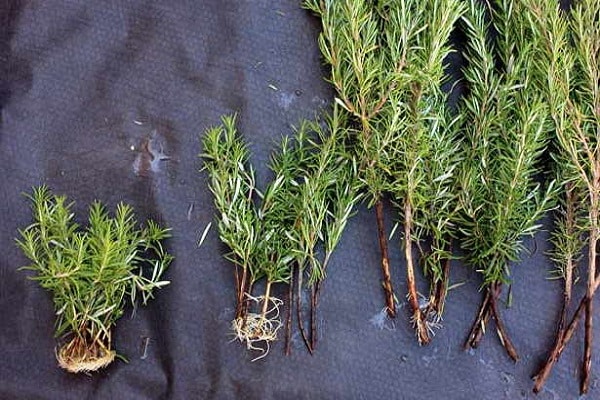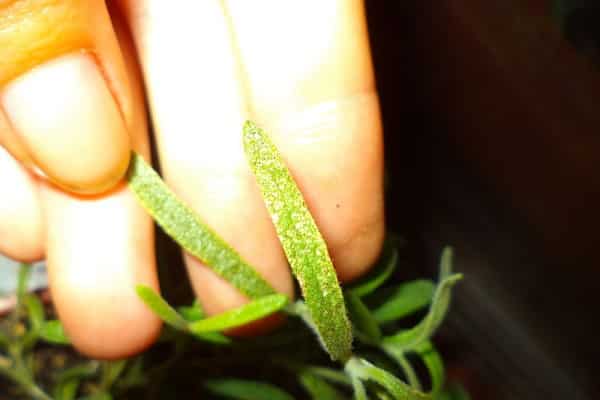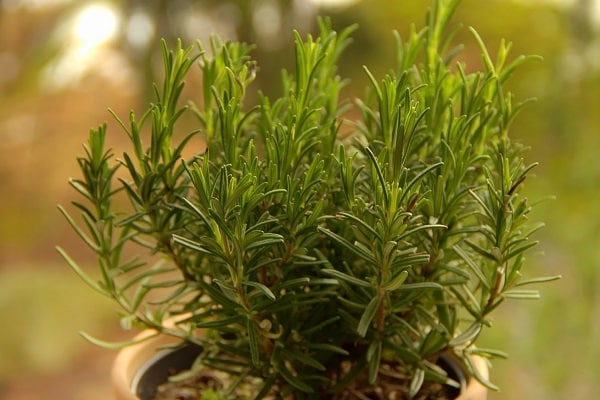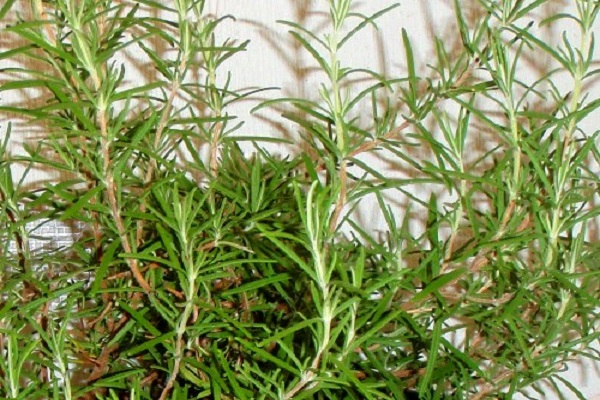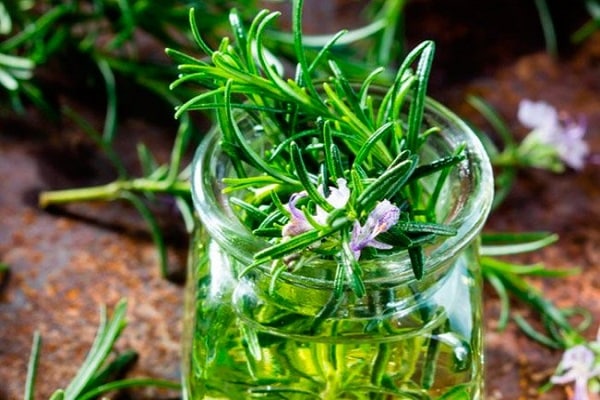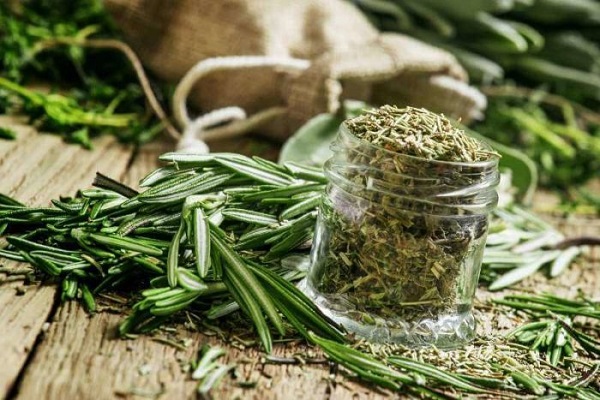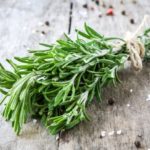For lovers of medicinal and spicy plants that came to us from the southern regions of the globe, there is an opportunity to grow them at home. Rosemary bushes, spreading the smells of freshness and the sea, will decorate the window sills of the room and will benefit human health. Growing rosemary in an apartment must be done competently, observing the requirements for growth conditions and care of the perennial.
- Description and beneficial properties of the plant
- Which varieties are suitable for growing in an apartment?
- Choosing a place for rosemary
- Selecting the optimal soil and pot
- Planting a plant
- Rules for caring for a plant at home
- Temperature, humidity and lighting
- Watering the plant
- Feeding and fertilizer
- Plant pruning
- Transfer
- Plant care in winter
- Methods for propagating rosemary
- Seeds
- Cuttings
- Diseases and pests
- Spider mite
- Aphid
- Mildew
- Application of the plant
Description and beneficial properties of the plant
There are two main types of rosemary, which are grown both in the garden and on windowsills in the apartment.
The ordinary, or medicinal, rosemary bush has a powerful root system. Erect shoots with hard, dense leaves reach a height of up to 1.5 meters. The plant blooms from March to June, covered with fragrant pink, violet, lilac, and white inflorescences.
The prostrate appearance of the plant is not tall, but is distinguished by the spreading crown of the bush in the shape of a ball.
The value of the grass and flowers of the perennial is in the high content of vitamin A, which is an excellent antioxidant and necessary for maintaining teeth and skin in order. The vitamin has a beneficial effect on the functions of the eyes and tissues of the whole body.
The plant is rich in iron, manganese, potassium, phosphorus, calcium. By supplying a person with them, spicy herbs contribute to:
- strengthening the heart muscle;
- hemoglobin formation;
- calming the nervous system;
- normalization of blood glucose levels;
- strengthening the skeletal and muscular system.
The fatty acids in rosemary leaf essential oil are beneficial for men, toning their reproductive system. Carnosic acid in the oil improves blood supply to the brain, delaying human aging and preventing tissue degeneration.
The herb is used to treat problems with the intestines and stomach, as its use reduces pain and spasms in this area. The antiseptic properties of the plant are known. No wonder lotions and compresses with rosemary infusion help with abscesses, eczema, and purulent wounds.
Which varieties are suitable for growing in an apartment?
To successfully grow rosemary in an apartment, you need to select varieties suitable for development at home:
- The Tenderness variety is distinguished by a bush height of up to 1 meter and an amazing aroma.
- The plant with a sweetish-spicy smell and unique taste of the leaves ensured the popularity of the Rosinka variety. The height of rosemary stems is 40 centimeters; it is suitable for culinary needs from the 2nd year of life.
- The Blue Jerboa variety grows low and is covered with fragrant panicles of inflorescences from March to May.
- Evergreen lavender rosemary has a spicy aroma and medicinal properties. The variety can be grown in pots in an apartment or in a garden.
- Tall Roseus will delight you with large flowers and a bush height of up to 1.3 meters. You will have to trim the crown to give the bush a beautiful shape.
- The container culture Corsican Blue grows well indoors, but in the summer you can take the pots out into the garden. It is distinguished by fragrant blue flowers, perennial shoots with leathery leaves. The upper leaf plate is smooth, light green, the lower leaf is pubescent.
All varieties of rosemary are used in cooking, medicine, and cosmetology. A houseplant is decorative and will decorate your home, bringing happiness and tranquility to its inhabitants.
Choosing a place for rosemary
Flower growers know how difficult it is to grow a tropical plant in an apartment and create the appropriate conditions. Long-term light is important for rosemary. Without sunlight, the plant will wither. It is best to place the pot with the crop on a southern windowsill. If it is impossible to allocate such a place in the apartment, then you will have to think about organizing additional lighting. To do this, attach fluorescent lamps above the container with rosemary.
Selecting the optimal soil and pot
Before planting rosemary, choose a soil substrate that is nutritious and well permeable to air and moisture. Leaf soil is suitable, but with the addition of sand and small crushed stone. In terms of acidity, the soil for the plant is suitable with a neutral or slightly alkaline pH.
The best composition will be one that consists of an equal amount of garden soil, compost and humus.
Rosemary needs a spacious container, such that the root system has enough space for full development. The material for the pot can be clay; in rare cases, wooden tubs are used.
Be sure to pour drainage made of expanded clay, pebbles or crushed stone at the bottom. To prevent moisture from accumulating in the container, holes are drilled at its base to allow excess water to drain into a tray.
Planting a plant
Like any indoor flower, rosemary must be planted so that the bush takes root and develops successfully. In addition to creating conditions, it is necessary to think over the rules for caring for the plant.
It is better to plant herbs for the home in the summer or at the end of winter, a month before the start of the plant’s growing season. A layer of drainage is poured into the pot, then a nutrient layer is laid. Having filled the pot one third, place the seedling there. Carefully straighten the roots of the plant, previously treated with a growth stimulator. Then sprinkle them with soil, lightly compacting them.
After planting, the plant is watered and placed in a warm place with good lighting.
Rules for caring for a plant at home
The rapid growth of grass and the possibility of using it depends on competent agricultural technology of the plant. The attractiveness of the appearance of the bush will tell you whether the flower is being taken care of correctly or not.
The pot of rosemary should always have moist soil. Concerns also include feeding the plant using fertilizers.Without creating appropriate illumination and air temperature for the grass, it will not bloom, and there will be little benefit from it.
Caring for a perennial is not difficult, but it requires some attention.
Temperature, humidity and lighting
From early spring to autumn, rosemary actively grows. During this period, the plant requires:
- air temperature 23-25 degrees;
- indoor humidity is within 80-85 percent;
- a large amount of fresh air, but without drafts;
- daylight for at least 12 hours.
In a well-lit place, the rosemary crown develops lushly, but one-sidedly. In order to avoid this, you must constantly turn the pot of herbs 180 degrees. In summer, when the sun is especially active, the tree is shaded by covering the window glass with sheets of white paper. In this case, less light enters and the leaves do not get burned.
Watering the plant
The homeland of rosemary is the Mediterranean coast, where air and soil humidity are high. Fragrant bushes should be watered regularly using settled, soft water at room temperature. But overwatering is dangerous for the plant. Stagnation of water in the pot will lead to rotting of the roots and death of the perennial. It will more easily survive a mild drought than waterlogged soil.
The plant will signal if it needs moisture when the tips of the leaves begin to turn yellow. When the top layer of soil in the pot dries out, be sure to water the plant. In extreme heat, spray rosemary in the morning and evening with warm water.
Feeding and fertilizer
During the growing season, rosemary must be provided with nutrients. Ready-made fertilizer complexes are suitable as top dressing. They are bred in accordance with the instructions and the plants are watered. Every 20 days it is necessary to shed the soil with a solution of bird droppings in a ratio of 1:30.
The soil for rosemary needs calcium; this must be taken into account when selecting fertilizers for the grass.
Plant pruning
Tall plant varieties must be pruned every 7 years. The procedure is carried out in order to rejuvenate the bush and help the growth of new shoots. Annual pruning of the tree is necessary to give the crown a beautiful shape. Decorative pruning is carried out at the beginning of the rosemary growing season, after the flowers fall off. During the procedure, scissors and pruning shears are used, which are pre-disinfected. The first time you can prune it is when the bush reaches 15 centimeters in height. After the crown of the plant has formed, the cut branches are used in cooking, adding spice to various dishes.
Transfer
Rosemary needs to be replanted annually in the first 5 years of life. It is necessary to carry out the procedure in April. To do this, select a new pot, which is 5-7 centimeters wider in diameter than the previous container. After 5 years, it is better to replant the grown rosemary once every three years. In this case, the diameter of the container increases by 10 centimeters.
Plant care in winter
From November to March, rosemary at home begins a dormant period, when the growth of the bush dies out. Plant care also changes at this time:
- The perennial should be watered less, avoiding drying out the soil in the pot.
- When growing rosemary in an apartment, the dryness of the air increases. To increase the humidity of the room, it is necessary to keep pebbles or moss moistened with water in a tray.
- There is not enough light for herbs in winter, so it is necessary to organize additional illumination with phytolamps, placing them at a distance of 25-30 centimeters from the bush.
- The air temperature in the room should not fall below 16 degrees Celsius.
- Overwintering of grass is successful when the plant is fed at least once with a mineral complex. Fertilizers are especially needed for those plants that were not transplanted on time.
The dormant period is the best time to prepare rosemary for active growth and development.
Methods for propagating rosemary
The evergreen plant can be planted from seeds and cuttings. The grass takes root quickly when it is propagated in April-May. You can plant rosemary for the winter, but there is a high probability that it will get sick and will not have time to get stronger.
Seeds
The seed propagation method is considered labor-intensive, requiring patience and time. But the seeds retain the varietal characteristics of the plant.
For propagation by seeds, purchase planting material in specialized stores. It is better to germinate them in advance by folding them in layers of damp gauze or paper napkins. If placed in a warm place, they will sprout quickly.
Containers for seeds are filled with nutritious soil and laid out on the surface of the soil, sprinkled with a thin layer of earth on top.
When everything is planted, water generously using a spray bottle. Cover the containers with film and place them in a warm room with a temperature of 18-20 degrees. It is necessary to ventilate the plantings every day and spray the soil with water at room temperature.
Shoots appear after 20-30 days. After this, the film is removed and the pots are placed on well-lit windowsills.
It is better to plant seedlings in separate containers after they have become stronger.
Cuttings
Easier propagate rosemary from cuttings. Side shoots are taken from adult plants, their leaves are removed from the lower part and placed in a container with water. Rooting of cuttings takes a long time - up to 1 month. During this time, it is necessary to change the water in the vase every 3-4 days so that it does not stagnate.
Planting of branches with roots occurs immediately in individual pots. A layer of drainage is poured into the container, and a third is filled with soil mixture. Having placed the cutting there, sprinkle it with earth and moisten it. The pot must be placed on a sunlit windowsill.
Cuttings take root well immediately in the ground. At the same time, the shoot is deepened by 3-4 centimeters. The top is cut off, then the rosemary will begin to form a powerful root system.
Diseases and pests
Improper plant care leads to fungal diseases, among which downy mildew is often found. The spicy aroma of rosemary repels pests. But infection with aphids, spider mites, and scale insects is possible.
Spider mite
The spider with 4 pairs of legs is so small that it is difficult to notice with the naked eye. Settling on the underside of leaves, it sucks juices from plants, entwining them with cobwebs. This is how the pest is identified. A heavily infected plant is treated with Tanrek and Actellik. You can get rid of mites by spraying with an infusion of onion peels, which is prepared from 20 grams of raw materials per 1 liter of water. The treatment is carried out three times with a break of 10 days. After using the chemical, the grass cannot be used for food.
Aphid
The small sucking insect is quite common and causes great damage to indoor plants. When a parasite appears on rosemary, it is necessary to spray the bush with tobacco decoction. 1 kilogram of shag or tobacco dust is diluted in 0.5 buckets of water. A day later, the solution is boiled for 30 minutes. For one procedure you need 0.5 liters of decoction diluted in 10 liters of water. The broth sticks better after adding 100 grams of laundry soap to it.
Mildew
The appearance of white spots on the leaves indicates that the plant is infected with a fungus. It is especially active when the room is humid and there is no access to fresh air. It is necessary to combat downy mildew with fungicidal agents such as Fitoverma. Processing is carried out up to 3 times.
Application of the plant
Medicinal rosemary is actively used in medicine. Valuable raw materials are prepared from shoots, cutting them off before or at the beginning of flowering.
1 tablespoon of plant leaves is poured with hot water in an amount of 400 milliliters. Infuse the medicine for 2 hours and drink half a glass before meals. It will help eliminate spasms of the intestines and gallbladder. A folk remedy is prepared from rosemary, which can be used for nervous disorders, general loss of strength, and insomnia. The drug helps people with impotence, colds, chronic bronchitis, and epilepsy. The infusion is used for inflammation of the throat and mouth as a gargle. They are used to wipe skin areas affected by eczema and inflammation. The infusion is used to combat acne.
Rosemary oil is used for rubbing and compresses in the treatment of rheumatism. Wine made from herbs serves as an excellent tonic; it dilates blood vessels and relieves nervous tension.
In cosmetology, rosemary leaf oil is added to ointments and creams to improve facial skin, shampoos to stimulate hair growth and strengthen its structure.
In cooking, the herb is added to various dishes and drinks.

